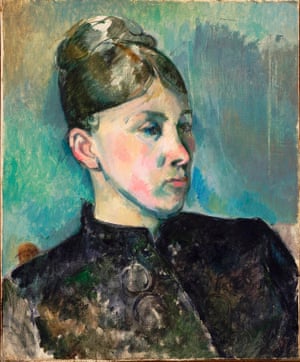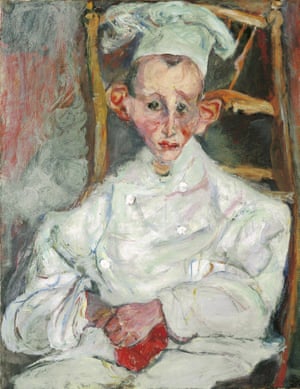cultură şi spiritualitate
Bringing more than 50 of Cézanne’s portraits together underlines their unyielding quality. Plus, the wildly original Chaïm Soutine

Paul Cézanne’s first portrait is thought to have been a painting of a man in his early 20s: a brooding, liverish fellow straight out of the Grand Guignol, or a novel by Mary Shelley. Dressed in a coat of blood-red velvet, his skin is tinged with green, his lips with a peculiar shade of tangerine. If his brow seems unnaturally wide, the forehead of a phrenologist’s dreams, then his inky moustache is certainly too sinisterly drooping. Above all, there are his eyes: joke-shop globes of black, white and scarlet that stare accusingly at all who stand before him. For a moment, I considered the thatch of his tobacco-brown hair. If I looked hard enough, would I find a pair of tiny horns in its midst?
It’s with something of a start that you discover this painting, arresting but just a little ridiculous, depicts none other than the artist himself (Self-Portrait, c1862-4). Cézanne, after all, claimed to be uninterested in human psychology; his portraits, stark and emotionless, are a “record of the thing regarded” (my italics), not an effort to capture the soul of the sitter. This one, however, is all mood, and little else: here is Cézanne’s notoriously combative personality reduced to an elaborate cartoon, a Halloween mask by way of Caravaggio. As such, it makes you wonder all the more about the later portraits (he painted almost 200 in his career). The gap – we might better call it a chasm – between this early intensity, and the sculptural blankness of the faces that followed is undeniably bizarre. Why, you ask yourself again and again, are there no shades in between?
The National Portrait Gallery’s major new exhibition, which brings together for the first time more than 50 of Cézanne’s portraits, confirms what I’ve long half-suspected, which is that while his depictions of people are easy to admire, they’re extremely difficult to love. Yes, the development of his technique, from brush to palette knife and back again, is impressive; the level of abstraction involved in the later work remains astonishing for the time. Looking at The Smoker, that famous painting of 1893-6, it’s impossible not to think of Braque and Picasso; Cézanne’s interest lies as much – if not more – in the unlikely geometry of the table on which his subject rests an elbow as in the man himself. But en masse, these paintings are as unyielding as flint. Only two performed that unholy trick of reaching my heart intravenously, without my even noticing a line had been administered. The first was Fortuné Marion (1870-1), in which there is something almost flirtatious – those cow eyes! – in the face of Cézanne’s hirsute, geology-loving friend. The second was The Artist’s Son (1881-2), where the tension between the way Cézanne depicts the young Paul, all gorgeous, mother-of-pearl flesh, and the grey-blue that shrouds the wider canvas, speaks of distance as well as love (he may have doted on his child, but he did not always live with him).
Included are several paintings of Cézanne’s wife, Hortense Fiquet (he made 29 in total). They intrigue, I think, simply by dint of the fact they’re so determinedly unintriguing, their subject appearing before us like an Easter Island statue (or, should she be sewing, a domestic servant). In Madame Cézanne in a Red Armchair (c1877), completed nearly a decade before their marriage, Hortense has a semi-regal appearance; her skirt, at least, is sumptuous, even if her face has a flat, mask-like quality. After this, however, Cézanne grows less interested in using dress as modulation. The stoniness takes over. Personally, I can’t go along with the conviction of the exhibition’s curator, John Elderfield, that in later portraits she is more “vulnerable”, unless he sees her impassivity as a shield. Look at the later Woman with a Cafetiere (c1895), moreover, and you’ll find much the same inscrutability. Here, a stranger’s coffee cup has almost as much to tell us as her face.

Also gathered together for the first time, along the Strand at the Courtauld Institute, are Chaïm Soutine’s portraits of cooks, waiters and bellboys, painted mostly in Paris in the 1920s and 30s, by which time the Russian-born Soutine (1893-1943) was newly wealthy, and thus able to patronise the establishments where they were employed. I urge you to see them, for they are wildly original, the artist’s interest lying in the contrast between his subject’s personalities, whether sullen or puckish, and their uniforms, garments that seek to reduce them to their mere function. Their ears, in particular, have an antic quality that may be unique to 20th-century art; the lugs of The Pastry Cook of Cagnes (1922-3) are as big as satellite dishes, and about 10 times as monstrous.
It is, you suddenly understand, in these twisted jaws and crimson jackets that Francis Bacon found such inspiration (it must be because there are only two works by Soutine in British public collections that I had not grasped this before). Soutine paints his boys – these portraits are mostly, though not exclusively, of men – like dukes, caps and toques where there might otherwise be a coronet, bow ties and aprons in place of ermine and velvet robes. It is moving to see, even if you find, as I do, the artist’s brushwork to be a bit lumbering at times. He doesn’t give them dignity, exactly. They’re as comical as they are stoical. But simply by having brought them out of their kitchens and corridors, they are at last seen: newly crowned kings of his studio, if not of the institutions whose expensive wheels it is their life’s work to oil.
Star ratings (out of 5)
Cézanne Portraits ★★★
Soutine’s Portraits: Cooks, Waiters & Bellboys ★★★★
• Cézanne Portraits is at the National Portrait Gallery, London, unti...
• Soutine’s Portraits: Cooks, Waiters & Bellboys is at the Courta...
Since you’re here …
… we have a small favour to ask. More people are reading the Guardian than ever but advertising revenues across the media are falling fast. And unlike many news organisations, we haven’t put up a paywall – we want to keep our journalism as open as we can. So you can see why we need to ask for your help. The Guardian’s independent, investigative journalism takes a lot of time, money and hard work to produce. But we do it because we believe our perspective matters – because it might well be your perspective, too.
I appreciate there not being a paywall: it is more democratic for the media to be available for all and not a commodity to be purchased by a few. I’m happy to make a contribution so others with less means still have access to information.Thomasine F-R.
Adaugă un comentariu
© 2024 Created by altmarius.
Oferit de
![]()
Embleme | Raportare eroare | Termeni de utilizare a serviciilor














Pentru a putea adăuga comentarii trebuie să fii membru al altmarius !
Alătură-te reţelei altmarius